Communicate with confidence: Understand and adapt to the 4 types of communication styles

Workplace success depends not only on your knowledge, skills, and performance alone but also on how you communicate with your coworkers. How you convey your thoughts, feelings, and needs can significantly impact the effectiveness of your communication. When you understand the different communication styles, you can interact and respond to your coworkers appropriately.
In this article, we will explore 4 types of communication styles and how to navigate through professionals using various communication styles.
What is your communication style?
Understanding and mastering different communication styles in the workplace can transform your interactions and improve professional relationships. There are four communication styles: passive, aggressive, passive-aggressive, and assertive.
By recognizing the characteristics of these styles, you can adapt your approach to foster healthier, more productive exchanges. Let’s explore each of the four different styles of communication in detail:
Passive communication style
The passive communication style avoids expressing personal opinions, feelings, or needs. Individuals who adopt this style often prioritize others' needs over their own which leads to a lack of self-assertion and personal expression. Passive communicators tend to sacrifice their own desires or needs.
Disadvantage- The primary disadvantage of passive communication is that it can lead to built-up resentment, low self-esteem, and a lack of personal fulfillment. When individuals consistently ignore their needs, they may feel powerless and unappreciated.
Example- A team member, in spite of being in a disagreement, is unable to speak up and ends up feeling frustrated and undervalued.

Aggressive communication style
This style is opposite to the passive style of communication. Aggressive communication involves expressing thoughts, feelings, and needs in a way that is often forceful and demanding. Aggressive communicators prioritize their needs and opinions over others, often disregarding others' feelings and perspectives. This style can lead to conflicts and strained relationships.
Disadvantage- While aggressive communicators may achieve short-term goals through assertive action, this style often results in long-term damage to relationships. It can lead to a lack of trust, decreased team morale, and increased stress among colleagues.
Example- An aggressive leader often interrupts his colleagues, speaks loudly, and dismisses any ideas that differ from his own.
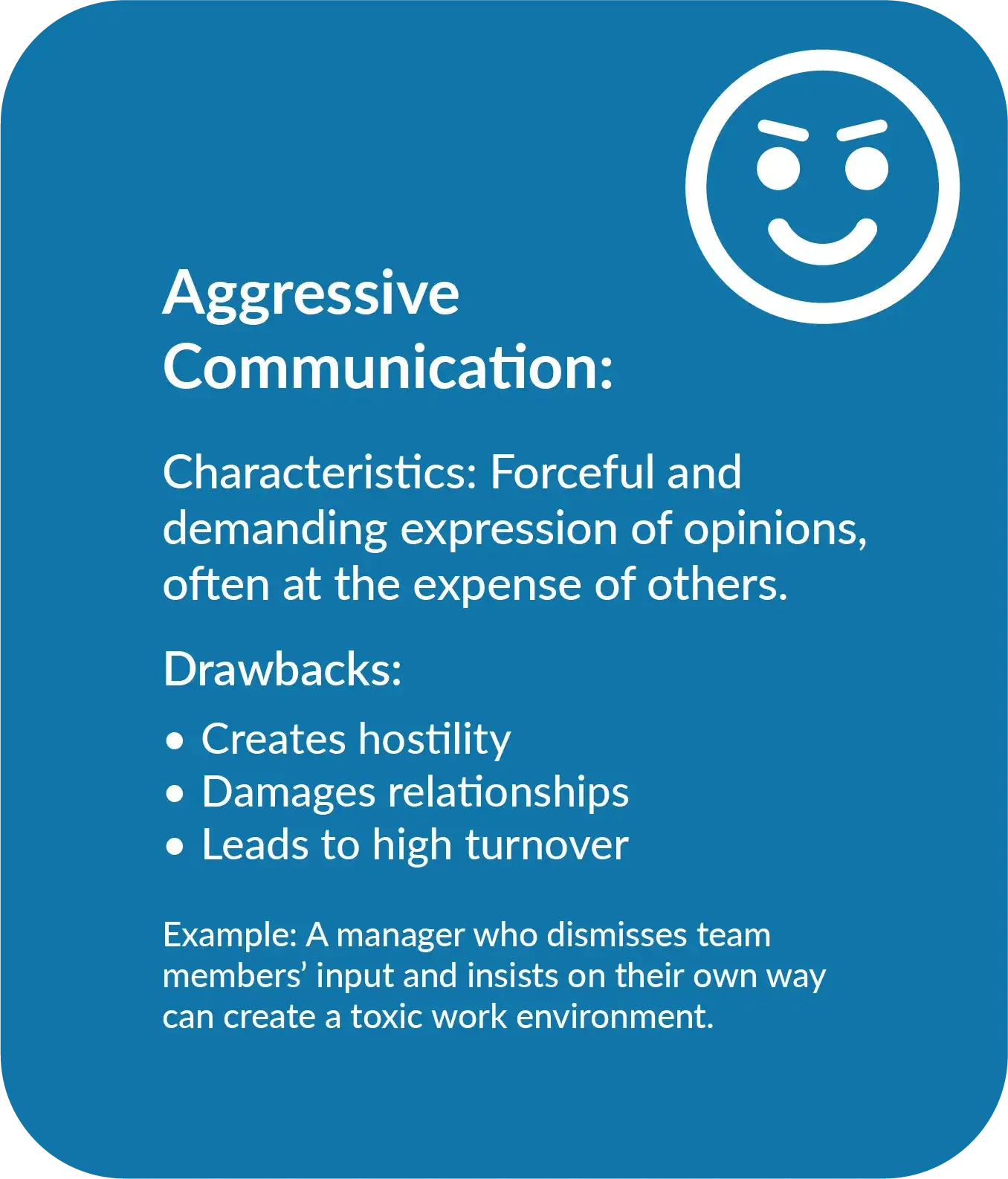
Passive-aggressive communication style
The passive-aggressive communication style is a blend of passive and aggressive elements. A passive-aggressive communicator often express their anger or frustration indirectly rather than confronting issues head-on. They may appear passive on the surface but engage in subtle, behind-the-scenes actions to express their discontent.
Disadvantage- Passive-aggressive communication creates an environment of uncertainty and mistrust. People using this style often do not address the issues openly, thereby leading to unresolved conflicts and ongoing tension. This style can undermine team cohesion and productivity.
Example- An employee who feels overwhelmed by the workload does not communicate the same to the management team. Instead arrives late at work, misses deadlines, and comments sarcastically about the workload.
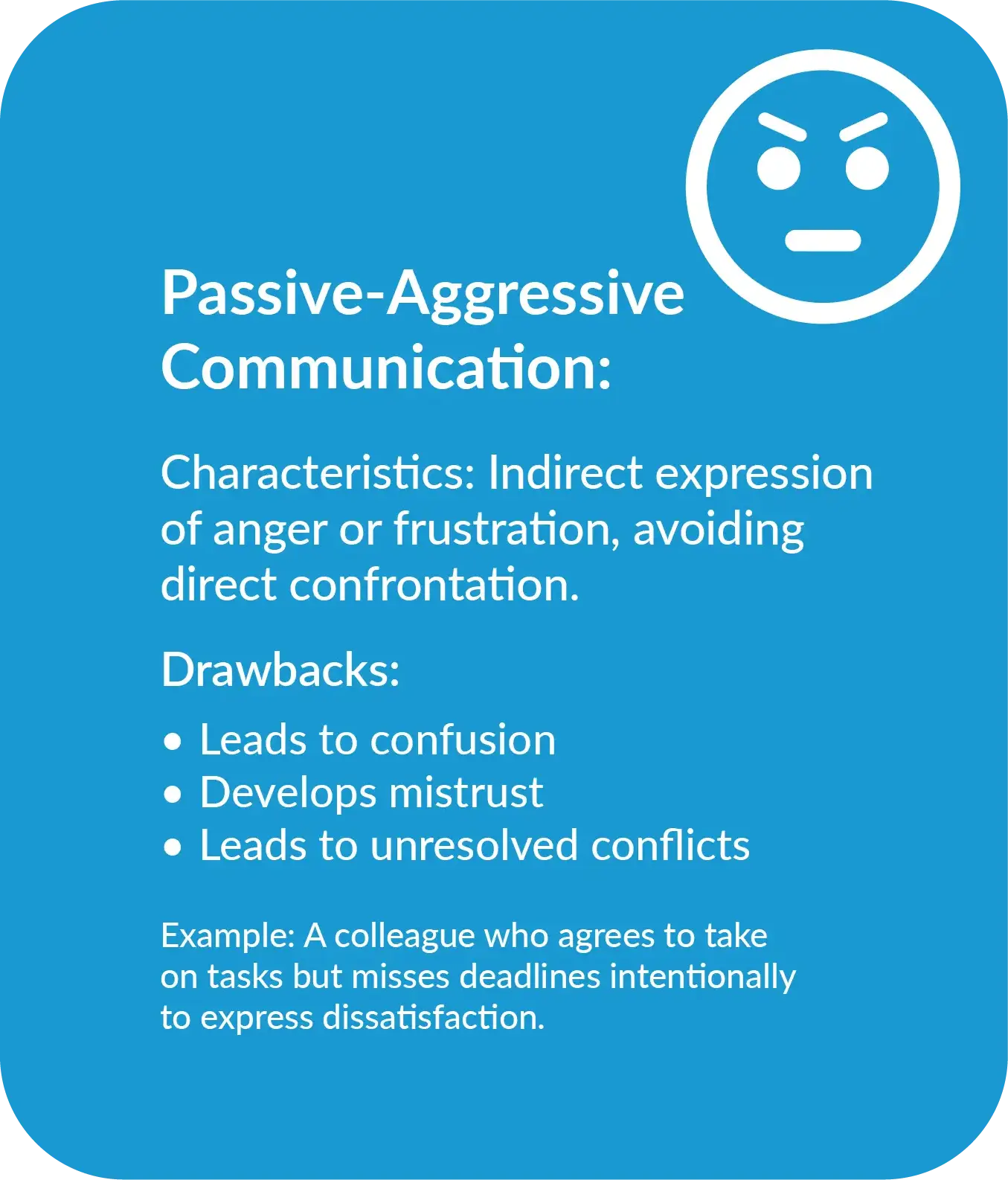
Assertive communication style
The assertive communication style is considered the most effective and balanced approach. Assertive communicators express their thoughts, feelings, and needs openly and honestly while respecting others' rights and opinions. This style fosters mutual respect, collaboration, and effective problem-solving.
Advantage- Assertive communication promotes healthy, honest relationships and allows individuals to express themselves without infringing on others' rights. This style leads to better conflict resolution, higher self-esteem, and more productive interactions.
Example- An assertive leader addresses conflicts confidently and encourages open dialogue, cooperation, and mutual respect.
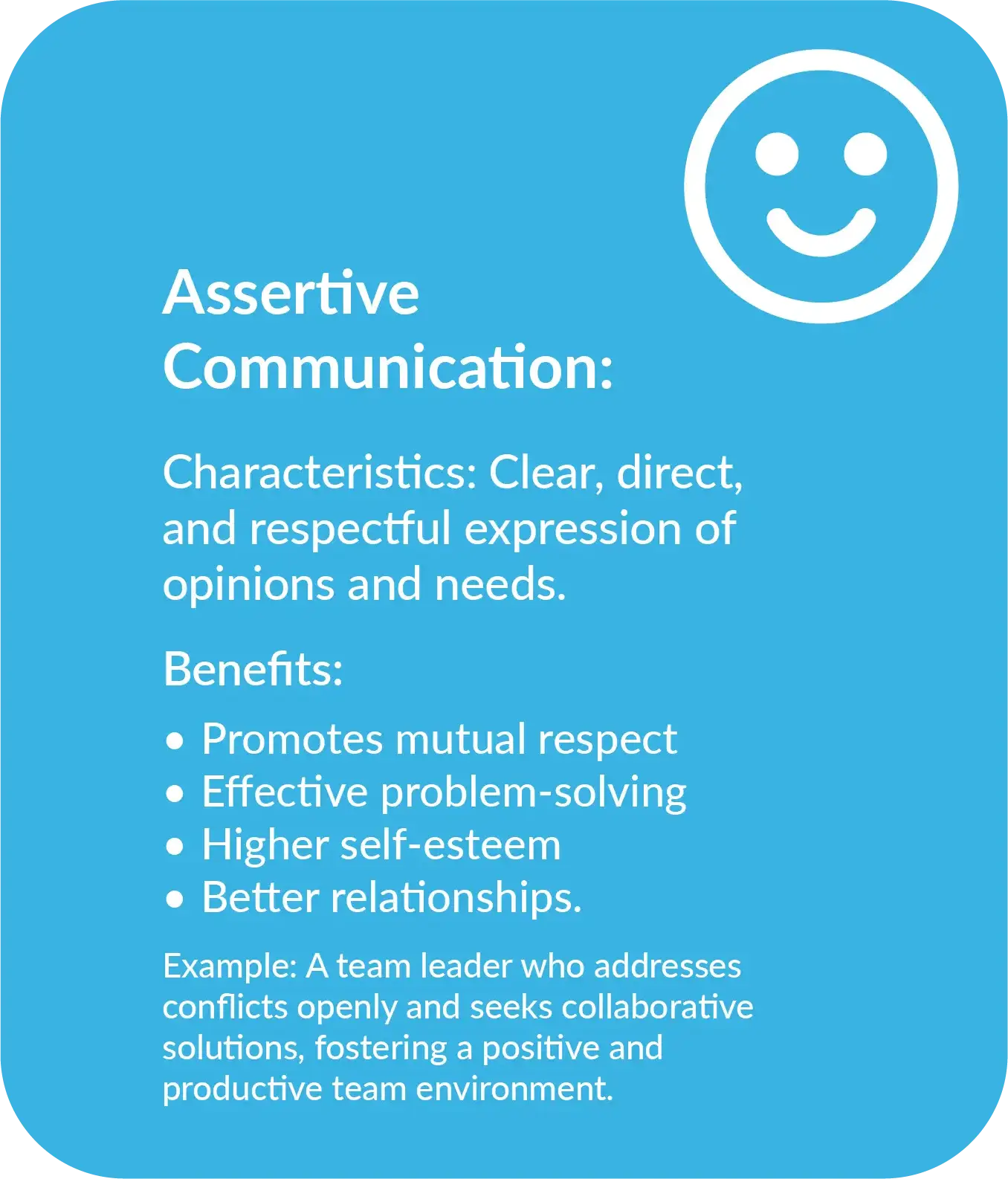
The ideal type of communication for the workplace:
Although assertive communication is often considered the most effective, it cannot be deemed the ideal communication style for every situation. Several factors influence this, including the following:
Varied use of communication styles
People rarely stick to just one communication style consistently. Instead, they typically have a primary communication style complemented by secondary and even tertiary styles they occasionally employ. For example:
- A manager might primarily use an assertive style to convey expectations and foster an open dialogue clearly but may occasionally adopt a passive style when wanting to encourage more input from team members.
- A team member might primarily use a passive-aggressive style due to their discomfort with confrontation but might switch to an assertive style when advocating for their needs during performance reviews.
Suitability of communication styles to different situations
Every communication style can be suitable depending on the context, working environment, and job demands. I am sharing some scenarios to explain this better:
- Aggressive communication: The aggressive communicator might seem too intense and commanding in most scenarios, potentially leading to conflicts and resentment. However, it can be beneficial in high-stakes roles where achieving challenging targets is critical. For example, a sales team lead might use an aggressive communication style to motivate their team to meet challenging sales goals. Their direct and high-pressure tactics can push the team to perform beyond their usual capabilities, which is crucial in competitive sales environments.
- Passive communication: While generally seen as ineffective due to its tendency to avoid confrontation and clear expression of needs, passive communication can be advantageous in situations where maintaining harmony is crucial. For example, a passive communication style in a collaborative project involving multiple departments might help defuse tensions and foster a more cooperative atmosphere.
- Passive-aggressive communication: Although often problematic due to its indirect expression of resentment or frustration, passive-aggressive communication might emerge in environments where direct confrontation is discouraged. For example, employees might use passive-aggressive communication to subtly signal dissatisfaction with a policy they feel powerless to change directly.
Essential qualities for effective communication:
There are fundamental qualities that are essential to pay attention to and practice, regardless of the communication style you are dealing with. These are the qualities commonly found in every great communicator. Let's look at these basic factors before exploring ways to handle different communication styles:
Recognize the relationship dynamics
Understanding the relationship between you and the communicator is crucial. Tailoring your approach based on this relationship helps you respond appropriately. Your approach to dealing with superiors and subordinates will differ from your approach to dealing with customers. For example:
- Superiors: A respectful and concise approach is often most effective when communicating with superiors, demonstrating deference and competence.
- Subordinates: Clarity and supportiveness are key when addressing subordinates. This ensures that instructions are understood and that team members feel valued and motivated.
- Customers: With customers, a service-oriented and empathetic approach is essential, focusing on understanding their needs and providing solutions.
Practice active listening
Actively listening to the other person before drawing conclusions is crucial. Active listening goes beyond merely hearing the words spoken; it involves fully engaging with the speaker. This includes:
- Asking questions: Inquiring further to better understand the other person’s situation and challenges.
- Reflecting: Repeating what you've heard to confirm understanding and show that you are engaged.
- Non-verbal cues: Paying attention to body language and other non-verbal signals that can provide additional context to the spoken words.
Develop high emotional intelligence
Great communicators typically exhibit high emotional intelligence, which includes the following five aspects:
1. Self-awareness: Being aware of your emotions and how they affect your communication helps you manage your reactions and responses more effectively.
- Example: Recognizing when you are frustrated and choosing to address it calmly rather than letting it impact your tone or words.
2. Empathy: Understanding and sharing the feelings of others. This allows for more compassionate and effective communication.
- Example: Acknowledging a team member’s stress during a busy period and offering support or flexibility.
3. Self-regulation: Managing your emotions in a healthy way, maintaining control over your impulses, and responding to situations thoughtfully.
- Example: Staying calm and composed during a heated discussion and addressing issues rationally.
4. Social skills: Building and maintaining healthy relationships through effective communication, conflict management, and collaboration.
- Example: Facilitating a team meeting in a way that encourages participation and collaboration, ensuring everyone feels heard and valued.
5. Motivation: Having a strong drive to achieve goals, which includes being optimistic and resilient even in the face of setbacks.
- Example: Demonstrating enthusiasm and commitment to a project, inspiring others to stay motivated and focused.
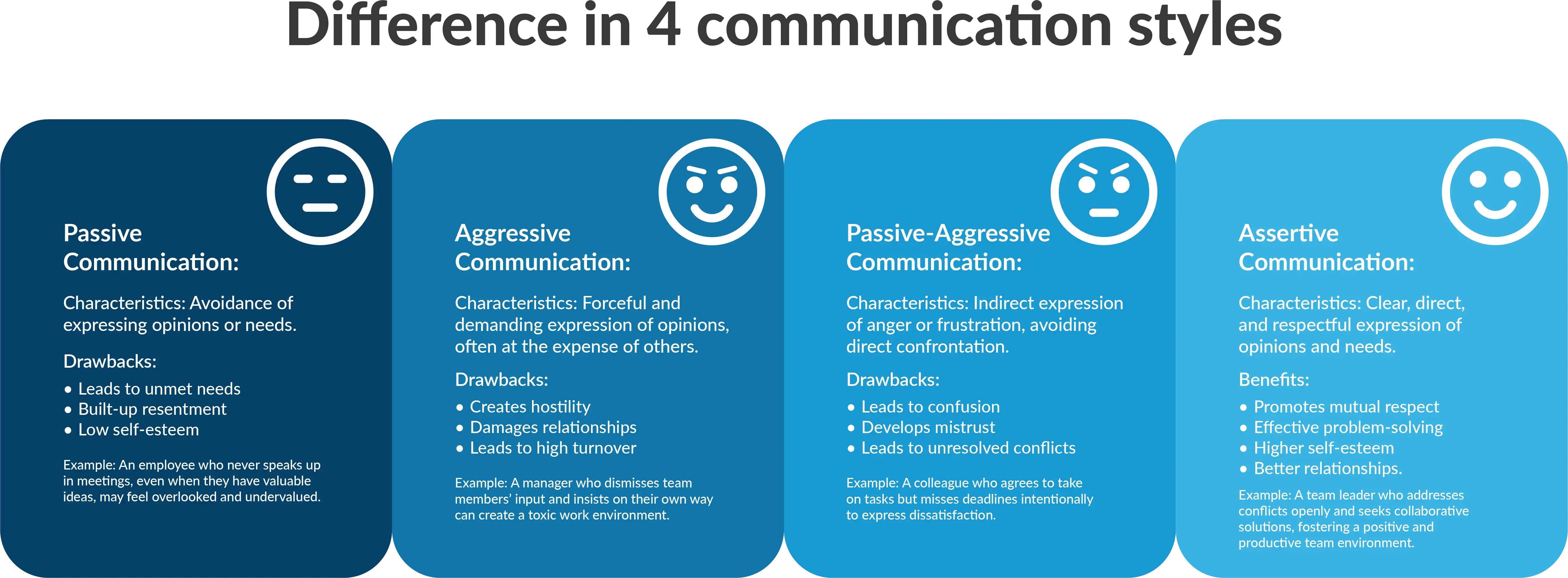
How to communicate effectively with people using different communication styles?
Effective communication in the workplace requires understanding and adapting to various communication styles. Each style presents unique challenges and opportunities. By tailoring your approach, you can foster better interactions, enhance collaboration, and improve overall productivity.
Here's a comprehensive guide to effectively communicating with assertive, aggressive, passive, and passive-aggressive communicators.
Assertive communicator
Assertive communicators are generally the easiest to interact with due to their clear and direct approach. Here’s how to communicate effectively with them:
- Recognize clarity: Assertive communicators are straightforward and appreciate the same in return. Allow them space to express their thoughts clearly.
- Be direct: Avoid passive or wishy-washy communication. Be direct and transparent in your interactions.
- Engage actively: Ask questions, listen attentively, and offer your own solutions and constructive criticism.
- Expect respectful dialogue: Prepare for a thoughtful exchange of ideas that leads to effective problem-solving.
Aggressive communicator
Aggressive communicators can be challenging due to their dominant and often intimidating approach. Here are strategies to manage such interactions:
- Engage remotely: Utilize remote communication platforms like Zoom to minimize the impact of their intimidating body language.
- Stay calm and patient: Maintain your composure and patience, and avoid reciprocating their aggressive tone.
- Express opinions: Ensure you express your opinions to avoid falling into a passive communication style.
- Provide constructive criticism: Offer feedback that helps them understand different communication styles and the benefits of a more collaborative approach.
- Encourage respectful dialogue: Promote active listening and a respectful exchange of ideas.
Passive communicator
Passive communicators tend to avoid conflict and prioritize kindness, often making them pleasant to communicate with but challenging to draw out. Here’s how to interact effectively:
- Be gentle and encouraging: Approach them with gentleness and enthusiasm, providing encouragement and support.
- Give space to speak: Ensure they have plenty of opportunities to express their thoughts, especially in one-on-one settings.
- Keep criticism positive: Frame constructive criticism in a positive, solution-oriented manner.
- Provide a safe space: Create an environment where they feel safe and valued, making it easier for them to share their ideas.
- Be tactful: Avoid outright dismissing their ideas, which could cause them to shut down.
Passive-aggressive communicator
This style of communication is detrimental to team morale and productivity. Here’s how to address it effectively:
- Use assertive communication: Address issues directly and assertively in one-on-one settings to understand the root of their dissatisfaction.
- Encourage self-reflection: Help them explore the source of their frustration and bitterness.
- Avoid passive-aggressive responses: Resist the temptation to respond in kind. Maintain direct and constructive communication.
- Acknowledge Contributions: Recognize their efforts and contributions while holding them accountable for their actions.
- Lead by example: Rephrase their concerns using assertive communication and demonstrate better ways to express their thoughts.
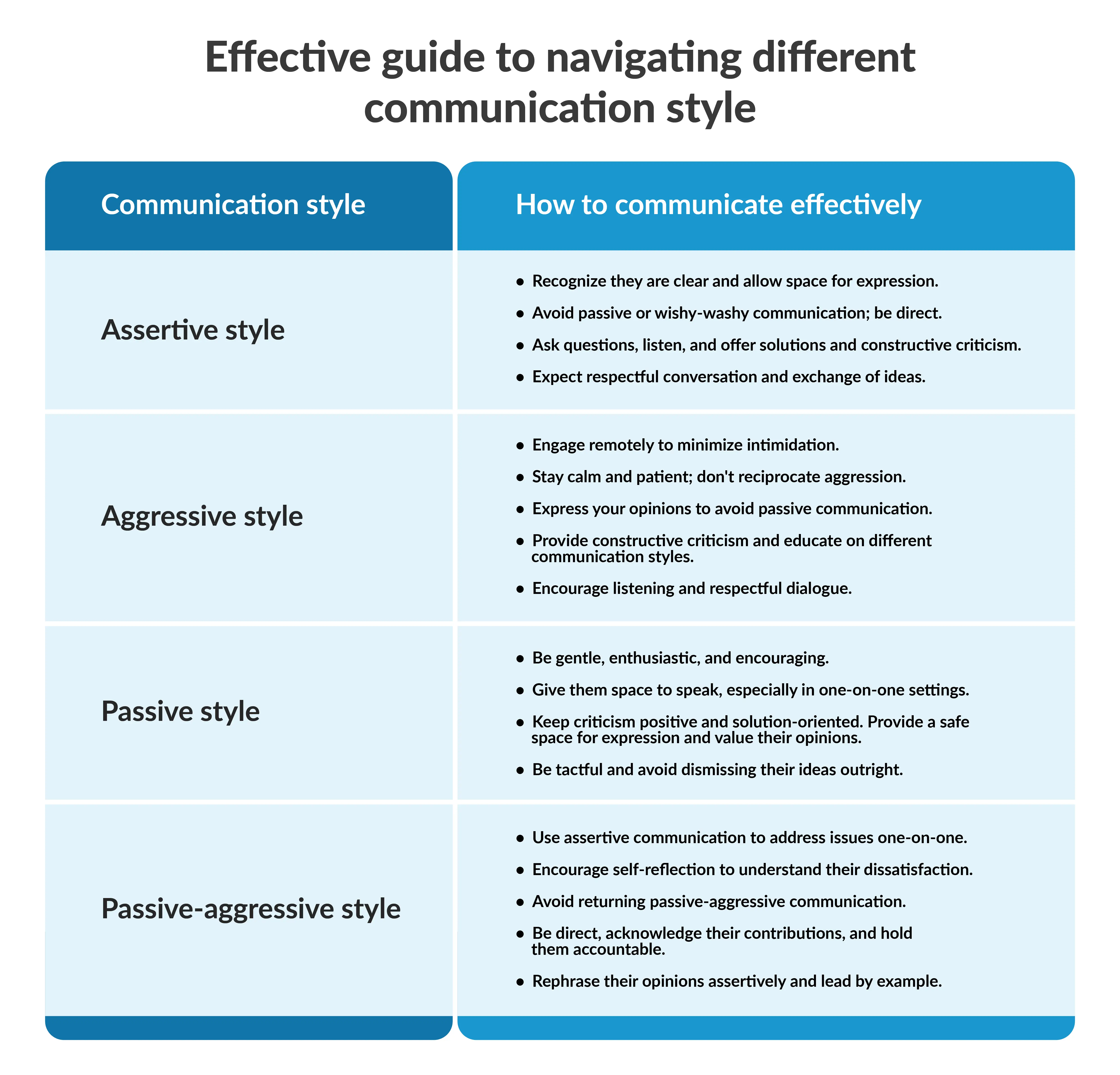
FAQs on communication styles
1. What are the different types of communication styles, and how do they affect workplace interactions?
Understanding the four main communication styles—passive, aggressive, passive-aggressive, and assertive—can help improve communication and foster healthier interpersonal relationships in the workplace. Each style has unique characteristics that affect interactions and productivity.
2. How can assertive communication improve workplace communication and interpersonal relationships?
Assertive communication allows individuals to express their thoughts, feelings, and needs openly while respecting others. This promotes direct communication, encourages honest dialogue, and leads to better conflict resolution and collaboration.
3. What are some strategies to manage aggressive communication styles effectively?
Engaging with aggressive communicators through digital communication platforms can help minimize confrontation. Staying calm, providing constructive criticism, and encouraging respectful dialogue can lead to more productive interactions.
4. How does passive-aggressive communication impact team dynamics, and what can be done to address it?
Passive-aggressive communication often results in misunderstandings and undermines trust within teams. Encouraging direct and honest communication can help address this style and improve interpersonal communication.
5. Why is understanding others' communication styles important for effective workplace communication?
Recognizing and adapting to different communication styles can help prevent communication breakdowns. Understanding others’ communication styles allows for tailored interactions that enhance collaboration, reduce conflict, and strengthen workplace relationships.
Improve your workplace communication with Prezent AI:
Prezent AI can significantly enhance your communication skills and help you navigate different communication styles effectively through the following features:
Fingerprint feature: Gain valuable insights into your audience's presentation style, data preferences, and more. This tool helps you tailor your communication to meet their needs effectively, regardless of their communication style.
Bite-sized online courses: Access engaging, thoughtfully curated courses with short videos and assessments. These interactive courses are designed to improve your communication skills incrementally, enabling you to adapt to assertive, aggressive, passive, and passive-aggressive communicators.
Zenith learning workshop: Receive guidance from industry leaders on business communication from experts. These workshops offer practical tips and strategies to help you and your team communicate more assertively and effectively, fostering better interactions with diverse communication styles.
These power tools help you develop versatile communication skills by helping you better understand your audience. This enhances your ability to confidently engage with any audience and convey your ideas.
Discover how Prezent AI can refine your business communication and presentations. Explore the platform with a free trial or schedule a demo with our experts to learn more about its powerful features and tools.




.avif)







